Client testimonials act as powerful social proof, convert prospective clients into buyers, and help ‘on the fence’ customers gain confidence about your product or service while increasing your brand’s credibility.
But not all client testimonials are the same. There are several types of testimonials you can choose from, specifically:
- Video Testimonials
- Quote Testimonials
- Social Media Reviews
- Case Studies
- Interview-Based Testimonials
- Success Stories or Before-After Stories
- Blog Post Reviews
- Third-Party Reviews
- Press Coverage
- Influencer or Authoritative or High Profile Testimonials
- User-Generated Content
And for each type, there are different ways you can position them on your site — you can put website testimonials on a checkout page, a popup bar, in emails, or on an exclusive page dedicated to testimonials.
So, we created this article to be an example guide to help you find a customer testimonial format that works best for you.
Below, we briefly discuss each of these 11 examples, including various ways of how different companies use them.
We’ll start with video testimonials.
1. Video Testimonials
Client video testimonials are engaging, authentic, and your potential customers get to see and hear real people talking about your brand. But many marketers shy away from video testimonials because they think it’s a daunting task:
- Looking for a location to shoot takes time.
- Coordinating a time where the interviewee and the shoot crew will be simultaneously present is difficult.
- Hiring a videographer and arranging for audio/video equipment is expensive.
- Preparing a script and shooting the video means spending long hours at the location.
- Video editing usually requires six+ weeks of time and specialized skills.
- The whole process requires time and effort from everyone involved, not just the video team.
We know all of this because we faced the exact same logistical hurdles with making our own high-quality client video testimonials, which we cover in detail in our founding story.
To solve this problem, we created Vocal Video, which is designed so that anyone can create a professional-looking client testimonial video without taking weeks of time and without paying for an expensive video testimonial service.
With Vocal Video, testimonials can be created asynchronously. The customer can record their testimonial on their own time, on their phone or computer, right from their browser — without having to download any apps or new software. You can then edit the video easily within the Vocal Video testimonial app without any editing skills or complex editing software. Our process and pricing are accessible for everyone, from small business users to enterprise marketing and sales departments.
Here’s an example of a finished video testimonial created using Vocal Video:
If You’d Like to Use Vocal Video to Record Testimonials, Here’s a Simple 4-Step Process
#1. Invite customers to record a video testimonial via email with a simple link.
Vocal Video’s video collector takes less than 15 minutes to set up and involves three to ten questions that you want customers to answer.
Note: Free plans include three questions, Essential includes five questions, and Pro and Scale include ten questions.
You can also add color and branding options, a welcome note, and an optional incentive to the customers to record a video testimonial.
In the end, you get an automatically generated link to the collector that you can send to your best customers. From there, they simply click on your link to start recording.
Take a look at our 48 different templates that help simplify the process.
Click here to read in detail about how you can collect video testimonials using Vocal Video.
#2. Customers use their own device to record a testimonial.
Customers don’t need to download any software or apps to start recording — they just click on the link you send and start the recording by answering your questions. When they are happy with their responses, they finalize the video, and you receive the testimonials.
You’ll also get a transcript of the video review that you can use in additional marketing materials (to help with SEO, product pages, and so forth).
#3. Receive a ready-to-publish, high-quality video testimonial that requires no editing.
Vocal Video pre-edits customer testimonials that you can then publish right away, but if you want to edit them further, you can easily use Vocal Video’s built-in suite of video editing tools, even if you have never edited a video before.
Check out more about Vocal Video’s optional editing tools here.
#4. Embed or host the testimonial on your website or social media platforms.
Embed codes and share links are generated automatically by Vocal Video and can be used on your product landing pages or dedicated testimonial pages to enhance conversion rates. You can display videos to website visitors in many appealing formats, such as a wall of love, carousel, grid, or slideshow. (And you don’t need to be a web design expert to do it!)
Here’s more information about sharing and embedding Vocal Videos.
Two Client Testimonial Examples Produced by Vocal Video
1. Aletha Health
Aletha Health is the company behind the HIp Hook and Nuckle, two muscle release tools that target muscles at the core of tension.
In this video, a happy customer shares his personal experience with the Hip Hook and narrates how this product solved chronic low back pain with psoas release.
Giving personal anecdotes makes this testimonial relatable as well as inspiring. People can also see the product held in the speaker’s hand.
The video also includes good questions, such as “What was causing your back pain?” which helps the interviewee get into the details of their own physical ailments and his journey to pain relief. The respondent is authentic, and thoughtful answers increase the credibility of the testimonial. Although the video review is recorded from home, light professional-grade production makes it more engaging for the viewer.
2. ACTIV
ACTIV is a marketing agency and growth partner that helps grow ecommerce brands.
ACTIV’s client, Zach Windahl, shares struggles prior to working with ACTIV and outlines exactly how the agency helped his business grow.
The speaker’s appreciation and excitement is authentic. The video review is professional, nicely edited, has the company branding, background music that isn’t distracting, and subtitles even though no professional video service was used to record it. The usual logistics of lighting, set, backdrop, and camera are completely done away with, and yet you have a great-looking testimonial video.
Template Questions Your Customers Can Refer to While Recording a Video Testimonial
Vocal Video offers 48 video collector templates for different situations and use cases, and each of them comes with sample questions.
For example, if you choose to create a customer testimonial video, here are three sample questions you can ask:
- Question 1: Could you describe a time that [your organization name] helped you?
- Question 2: How would you describe [your organization name] in three words?
- Question 3: What is something about [your organization name] that makes it unique?
A post-purchase product review from an e-commerce company can contain these questions:
- Question 1: Could you describe why you purchased our product?
- Question 2: What has been your experience with our product so far?
- Question 3: Could you describe your overall experience with [your organization name]?
Though these questions are simple, they help customers reflect and put into words the impact your organization has created for them.
If you’re interested in trying out video testimonials, create a free Vocal Video account, no credit card required.
2. Customer Quote Testimonials
Quote testimonials are the simplest way to display customer testimonials. Customers share their experience about using your product or service in a short written quote. They can exist with or without images and can be presented in several different ways. They are often followed by a call-to-action (CTA) inviting potential customers to give your product or service a try.
Here are four examples:
1. Basecamp
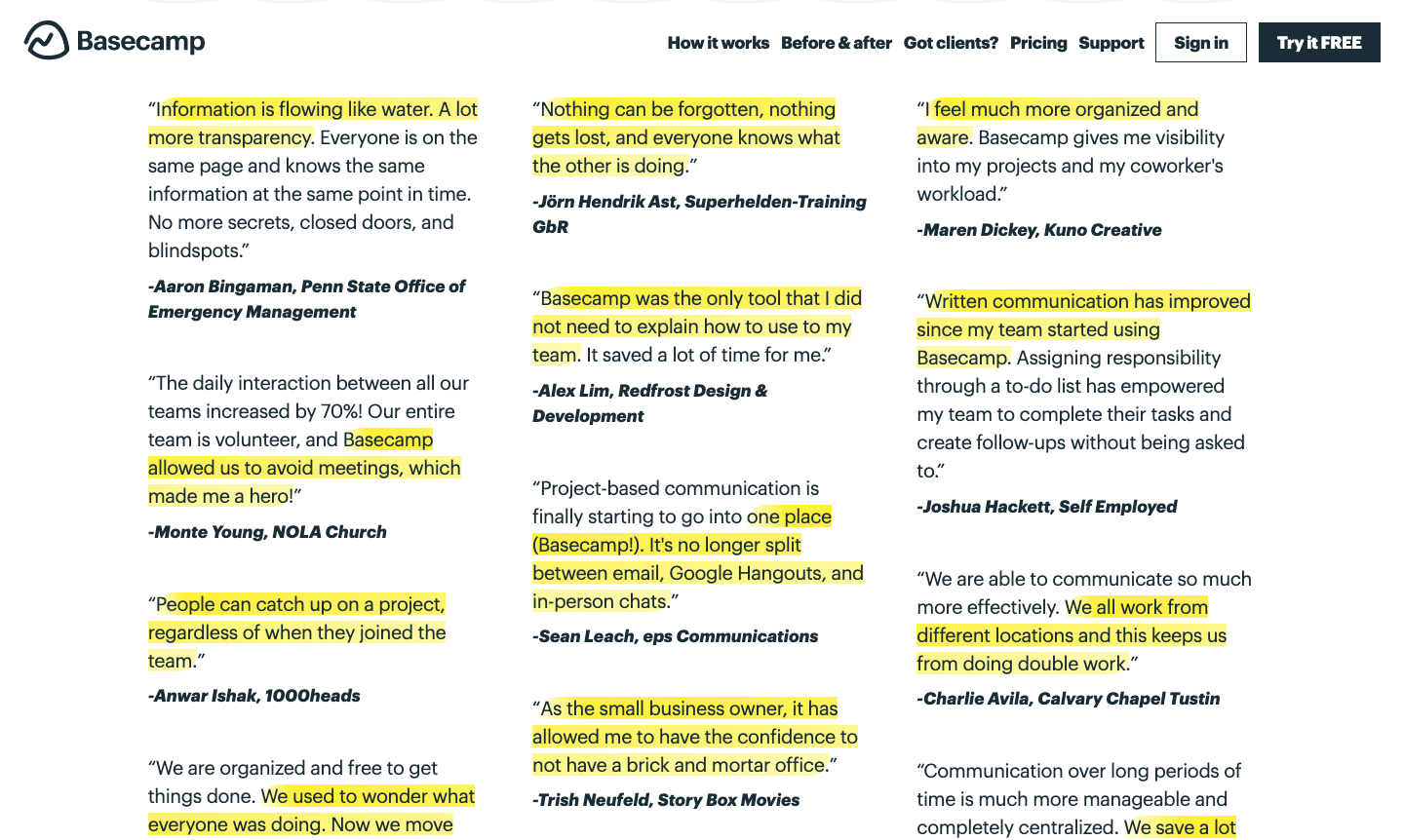
Basecamp, a popular project management software, dedicates a whole page to customer testimonials. Testimonials are done simply — they have no photos, just the name, designation, and the positive feedback.
What stands out here is: The testimonials are small, a maximum of five sentences and the benefits that customers have gained by using Basecamp are highlighted in yellow, which makes it easy to scan and read.
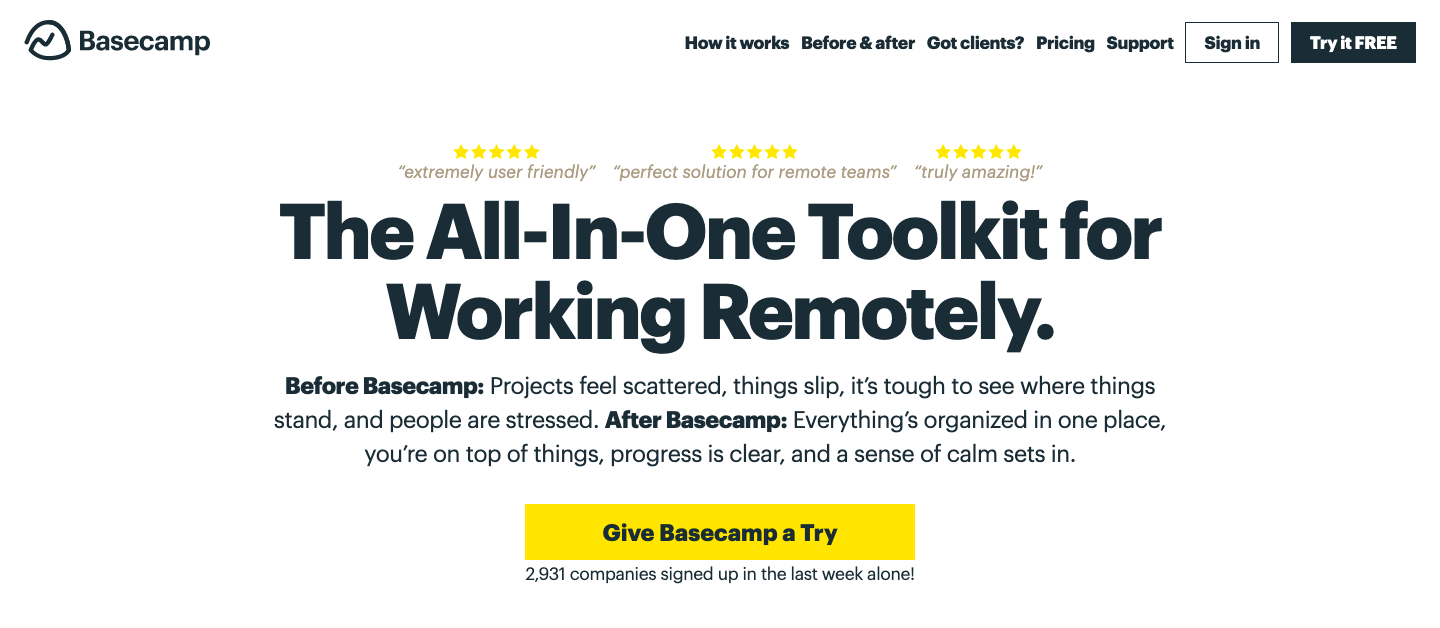
They also use testimonials on their landing page with specific features relating to project management like “extremely user friendly” and “perfect solution to remote teams”, along with 5-star ratings, as shown above.
2. Canva
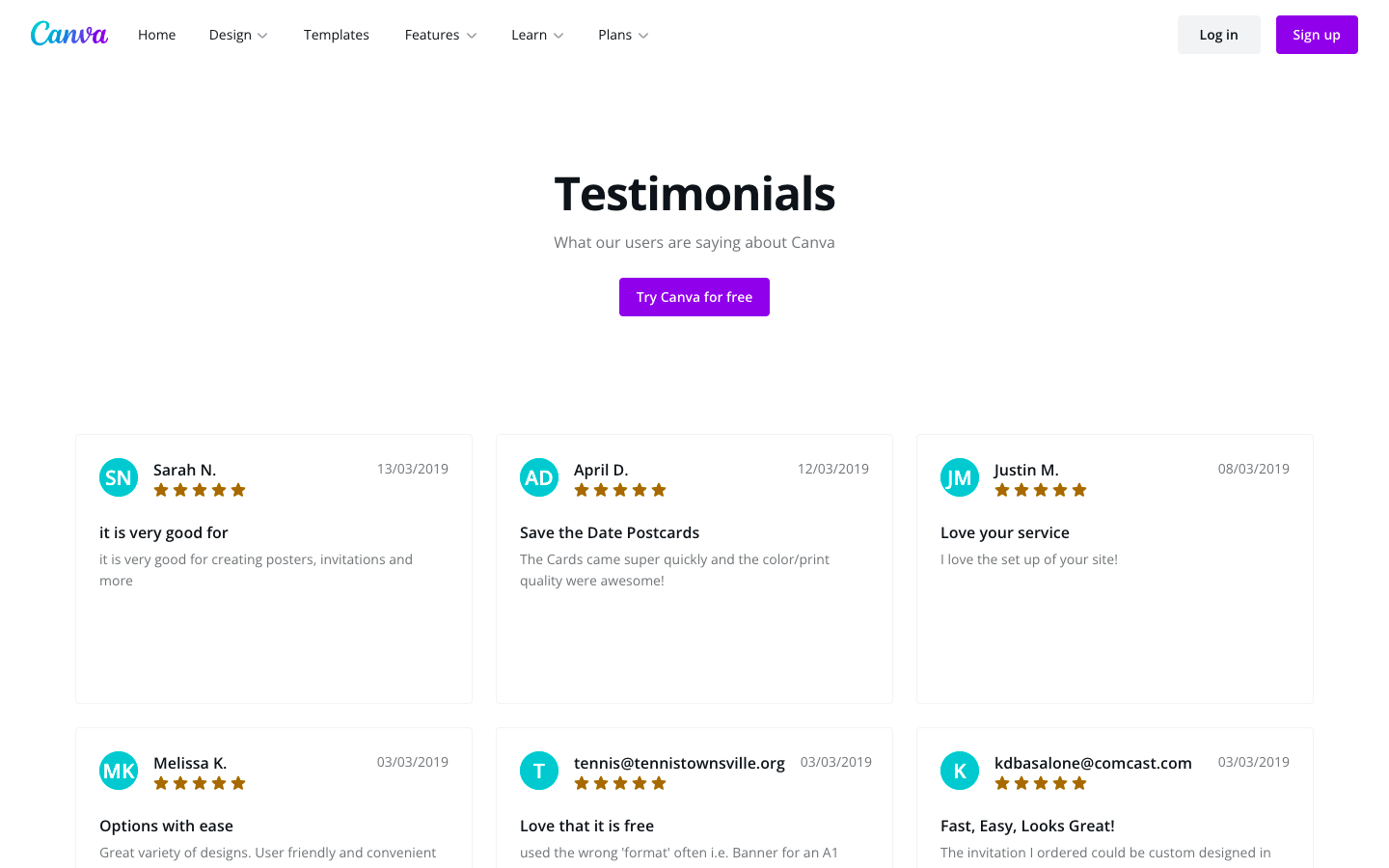
Even Canva doesn’t use photos of their users, but they make testimonials look more credible by adding a 5-star rating. Notice that most testimonials are just 1-2 sentences.
3. Kissmetrics
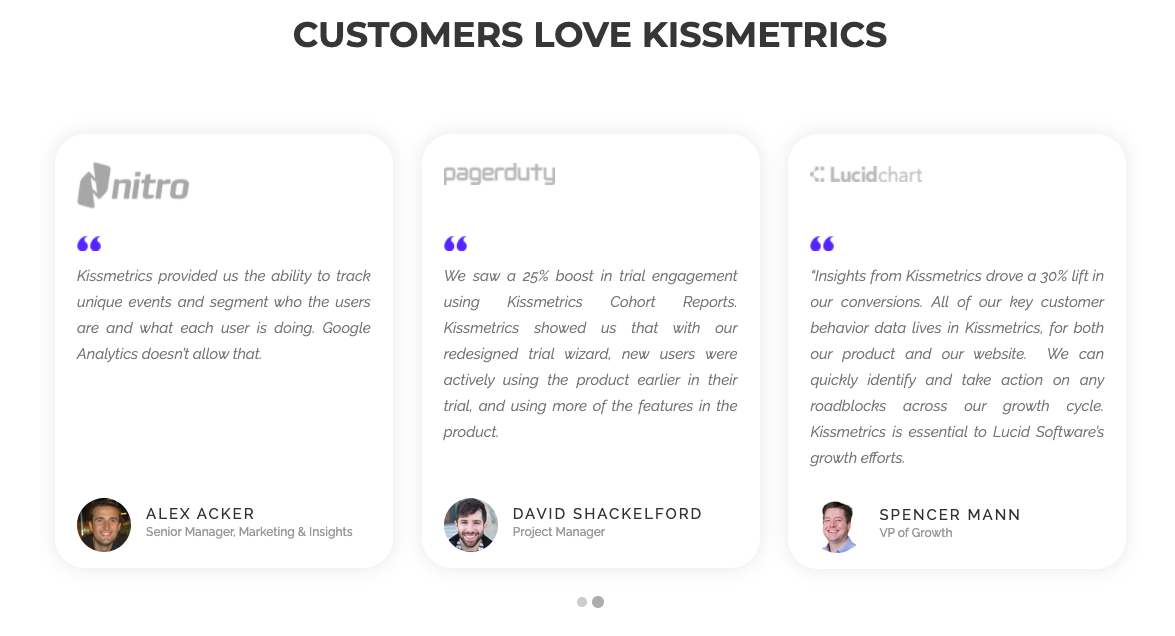
Kissmetrics keeps their testimonials on their homepage. Their testimonials include photos of their customers, complete with their designation and branding of the organization they work for. This is one of the most common ways to present quote testimonials.
4. OptinMonster
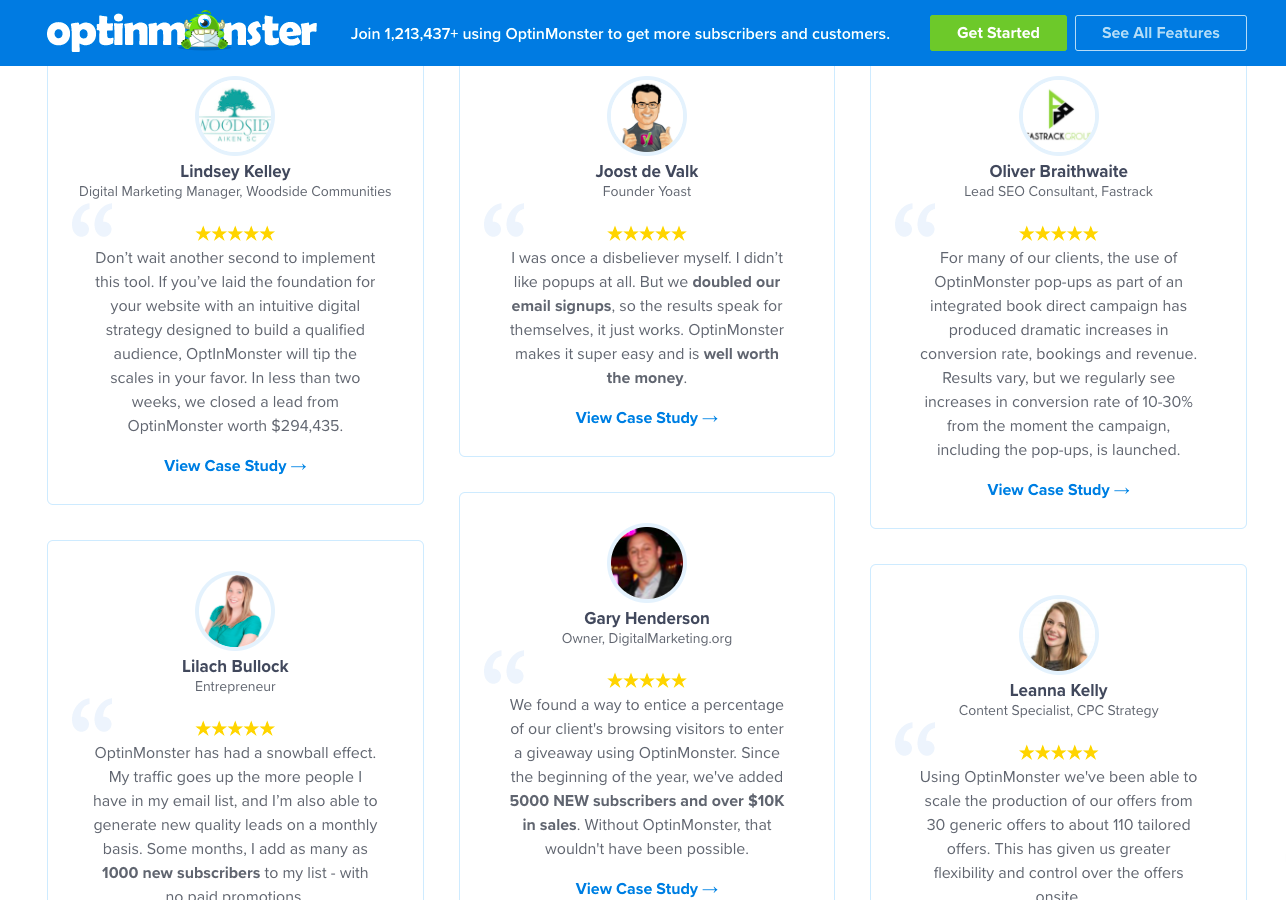
OptinMonster has a slight variation by bolding specific text statistics like “doubled our email signups”, “added 5000 new subscribers”, and “well worth the money”.
Takeaways:
- Adding a photo and designation of the client writing the testimonial can help make testimonials more believable instead of just putting up the text. Plus, including a five-star rating may increase credibility.
- Mentioning a statistic about how your product helped grow your business can also help add credibility to your testimonials while also appealing to both logic and emotion, as shown in the OptinMonster example above. Formatting options like bold and italics can also help statistics stand out.
- To go beyond testimonials that just speak in superlatives or plain one-liners like “Your product is the BEST” or “I love your product”, you can try to encourage your customers to write about the value your product has created for them.
- Quotes testimonials are versatile in their positioning — you can place them anywhere: landing page, checkout page, popup bars, social media, and even the contact us page.
Here’s a template you can use:
“[Your product/organization's name] helped our organization [add 2-3 benefits].
Looking at the numbers [add statistics related to your benefits], [your product name] has [end result achieved]”
Social media testimonials include reviews from customers on Twitter, Facebook, Instagram, and other media channels. Since social media post reviews appear on clients’ personal social profiles, they feel relatable and like real customer feedback.
Here are two examples:
1. Sprout Social
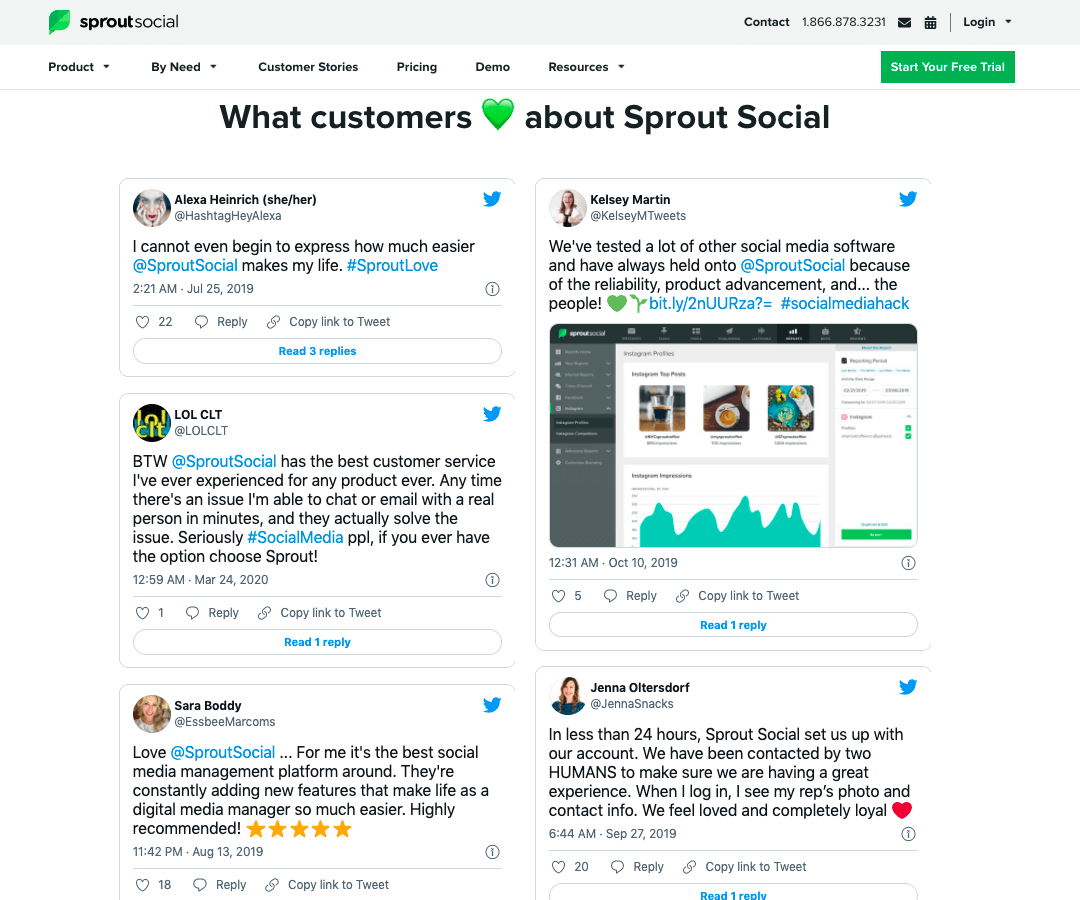
Sprout Social has a list of tweets from customers who love using their service. Because they are direct embeds from Twitter, they feel extremely credible.
2. Vocal Video
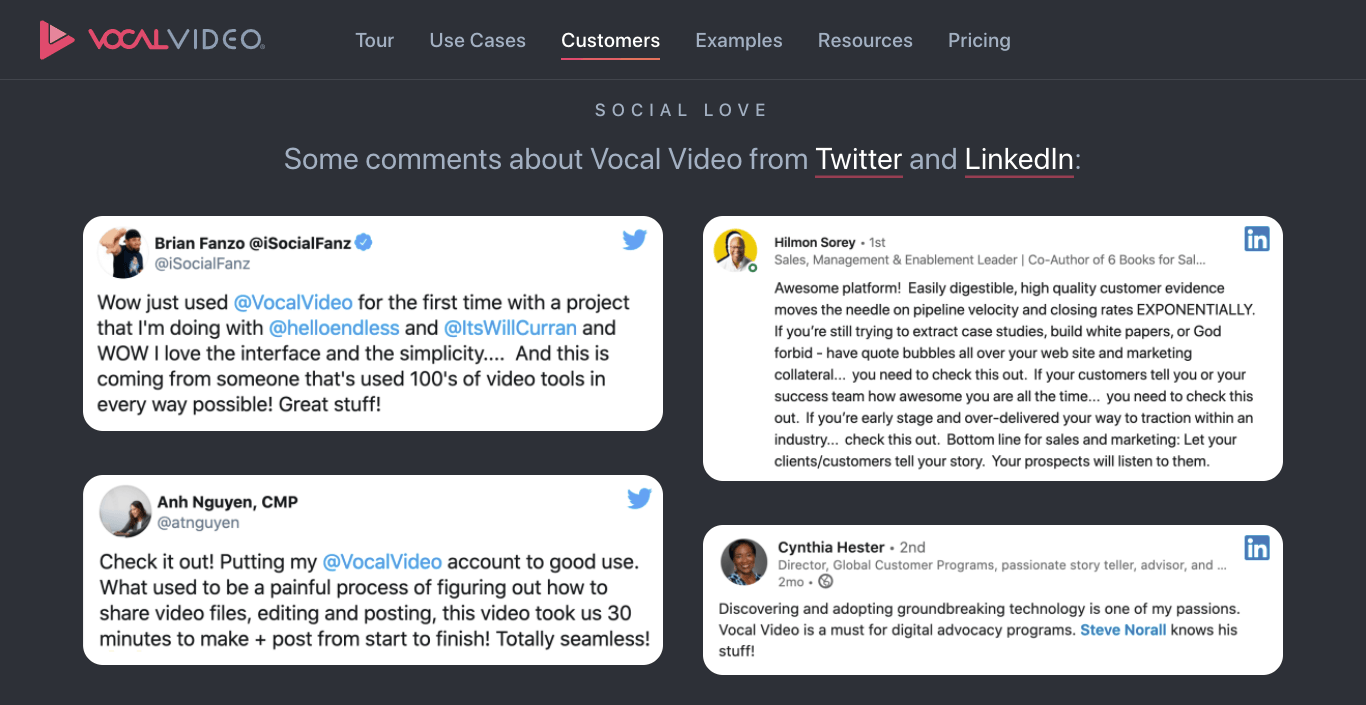
We embed videos, tweets, and LinkedIn testimonials on a dedicated customer testimonial page, as shown in the image above.
Takeaways:
- Notice how people tend to talk more informally and personally about products on social media (check out all the exclamation marks in the above tweets).
- You can embed tweets and other social media testimonials on your testimonials page or homepage. Basically, they can go anywhere a quote testimonial would go.
4. Case Studies
Case studies help prospective customers understand how a product has made a difference in existing customers' lives.
When you look at the examples we’ve linked to below, each of these case studies are like long-form articles and highlight significant changes that a customer noticed after using the product.
Case studies not only build reputation and trust but help in outlining your organization’s unique strategies or processes that get results for your customers. These work in a way that a simple quote testimonial or tweet may not be able to.
Here are three examples:
1. Slack
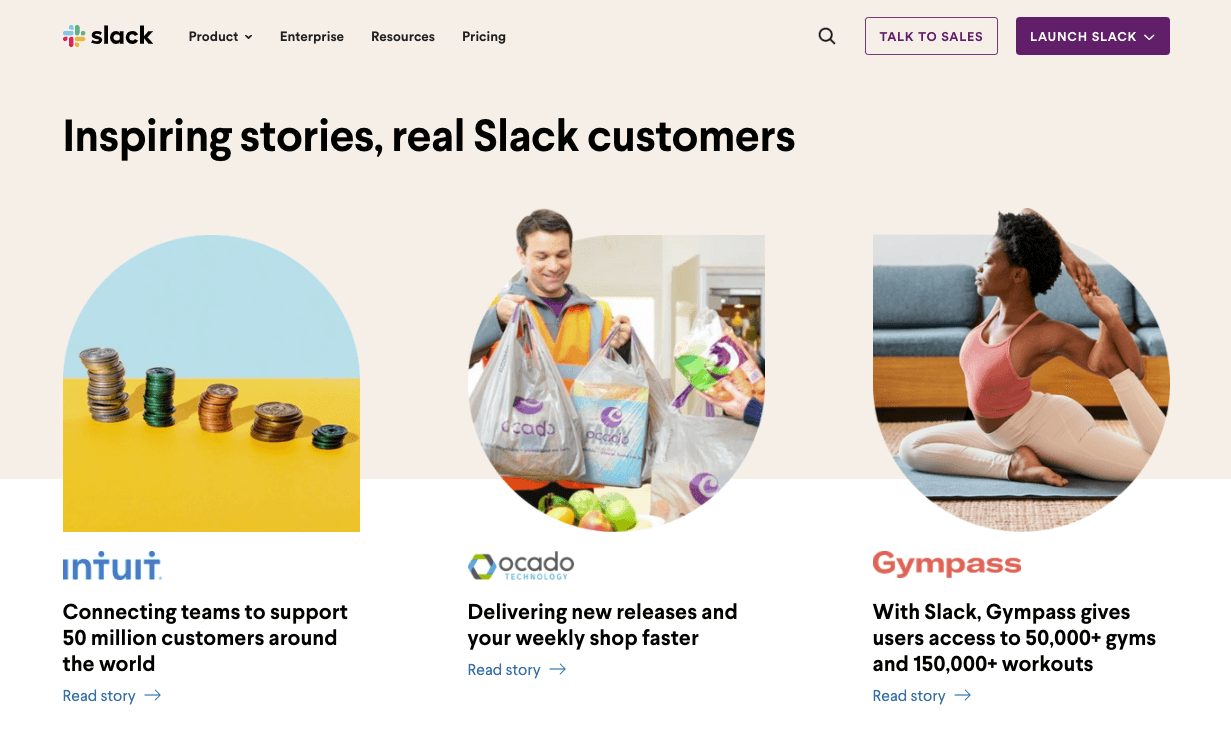
Slack customer stories are full-page case studies on how organizations use Slack to manage their teams and stay more connected, work faster, and with more efficiency.
Once you click into a particular case study, the featured brand has a quote and video testimonial, in addition to a detailed case study.
The page is filled with photos of people from the featured organization, and breaks down their experience of using Slack in highlights, as shown below.
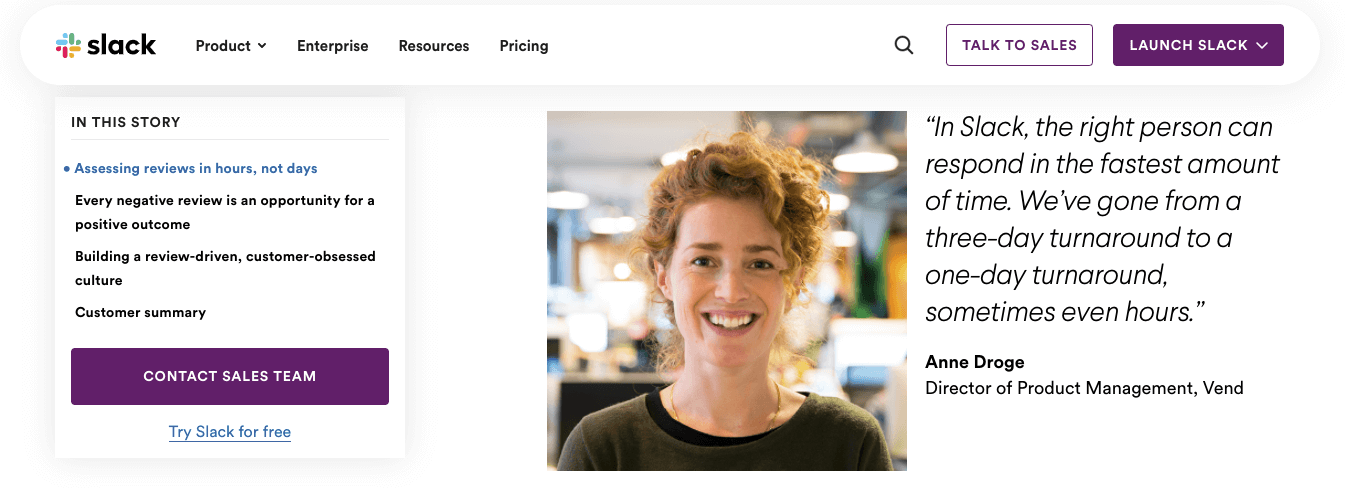
The page is filled with photos of people from the featured organization, and breaks down their experience of using Slack in highlights, as shown above.
2. Hootsuite
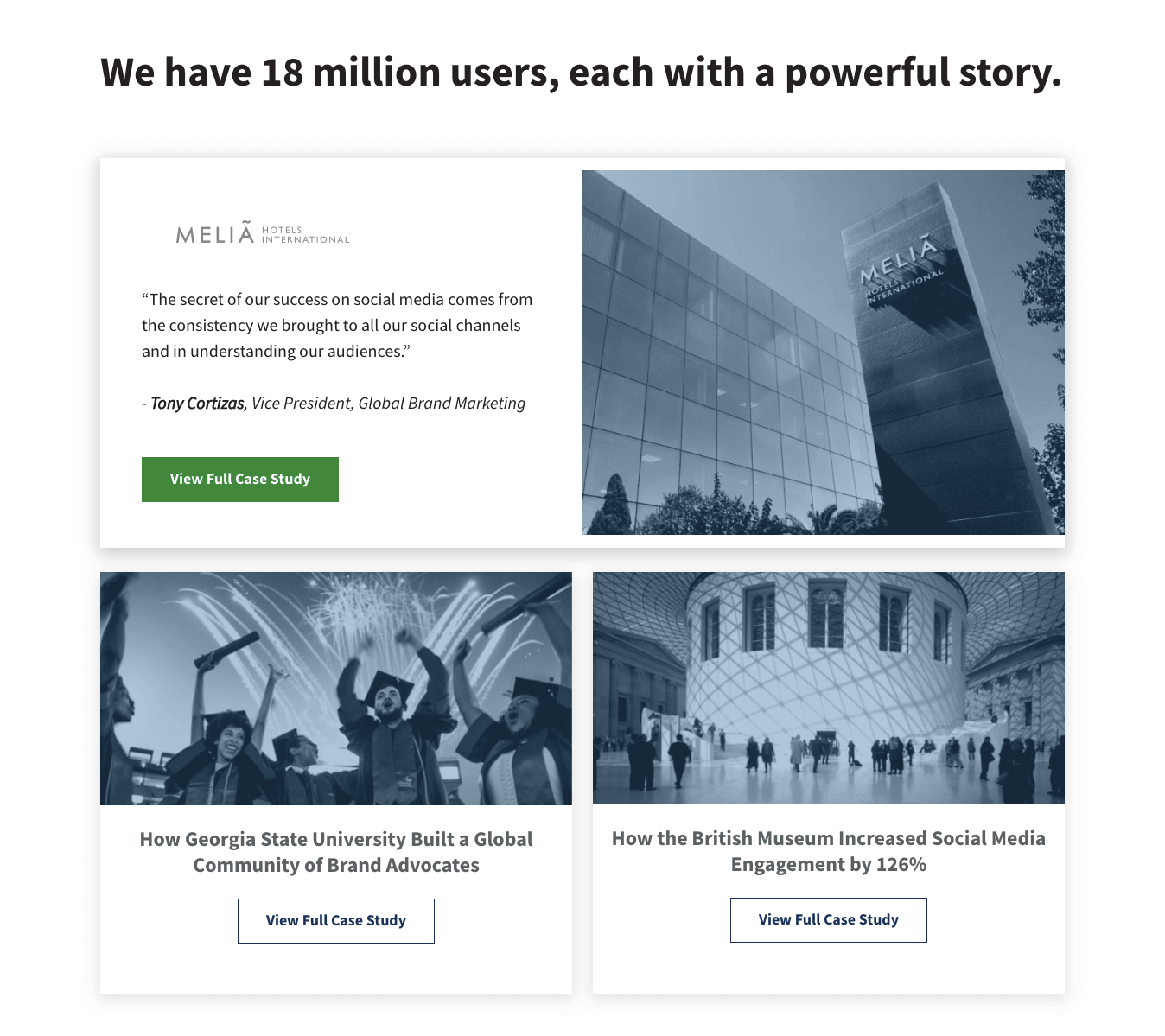
Hootsuite's customer stories page is designed simply with a powerful headline that reads, “We have 18 million users, each with a powerful story.”
Every client’s case study has a relevant photograph and a captivating, clear, and data-backed headline that invites visitors to read the full case study.
3. Airbnb
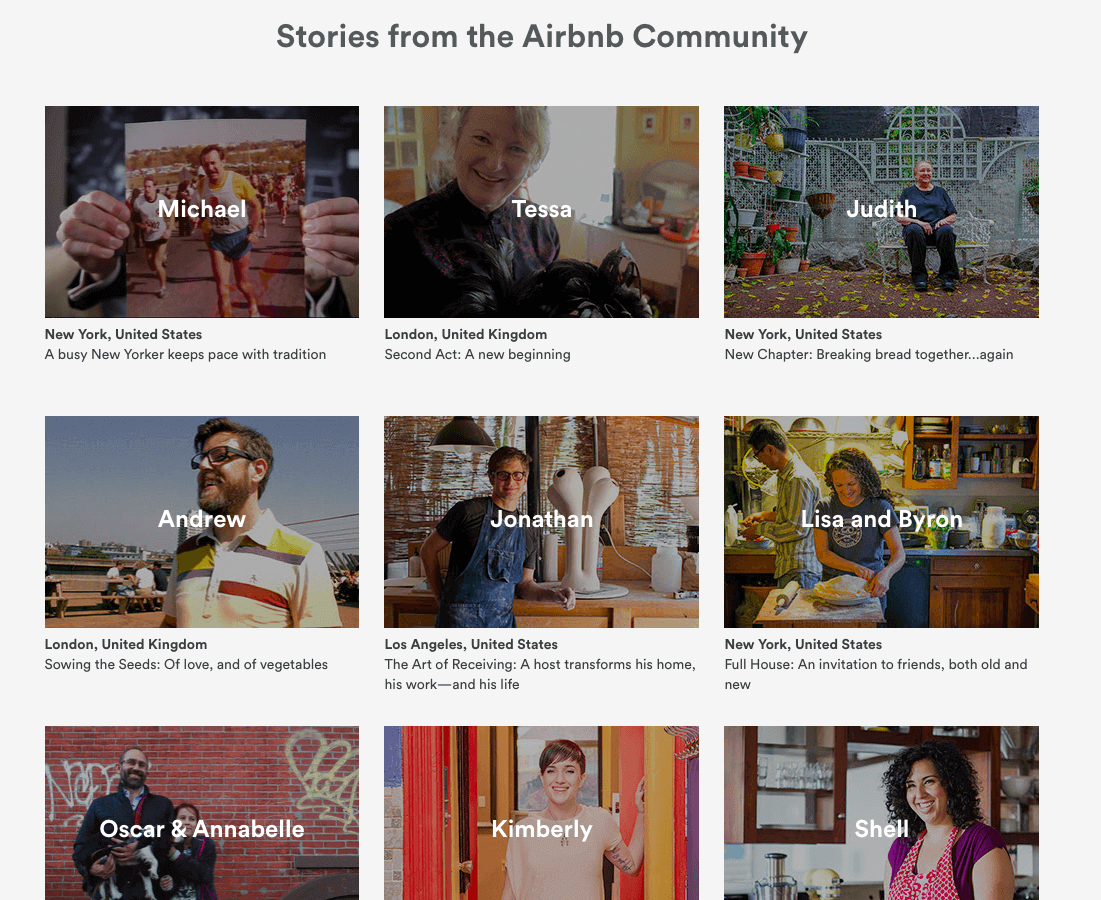
Every Airbnb case study features personal photographs and videos of the person who is sharing their positive experience. This immediately appeals to the emotions of the visitors, and their intriguing titles make this page irresistible to go through.
Takeaways:
- Bright photography: All of them have captivating and bright photography that invites customers to click through the case study, and most have photos of people that make the whole page look more human and credible.
- Click-worthy headlines: The titles of the case studies usually describe a powerful benefit you get out of the product.
- Simple static page design: There aren’t many elements; the design is simple with readable fonts.
A template you can use:
While a case study testimonial can’t be templatized, you can use the following structure to create one:
- How did your client come to know about your organization?
- What problems was their business facing? How was it affecting their business?
- What results did they want to achieve?
- How did your product or service help your client achieve those results?
- What were the specific features they used to get the most benefits?
Click here for an additional list of 16 thoughtful questions that you can use to create powerful case studies.
5. Interview-Based Testimonials
Interview-based testimonials are simply putting up interviews of your customers in written or video format.
Here are three interview-based customer testimonial examples:
1. Codecademy
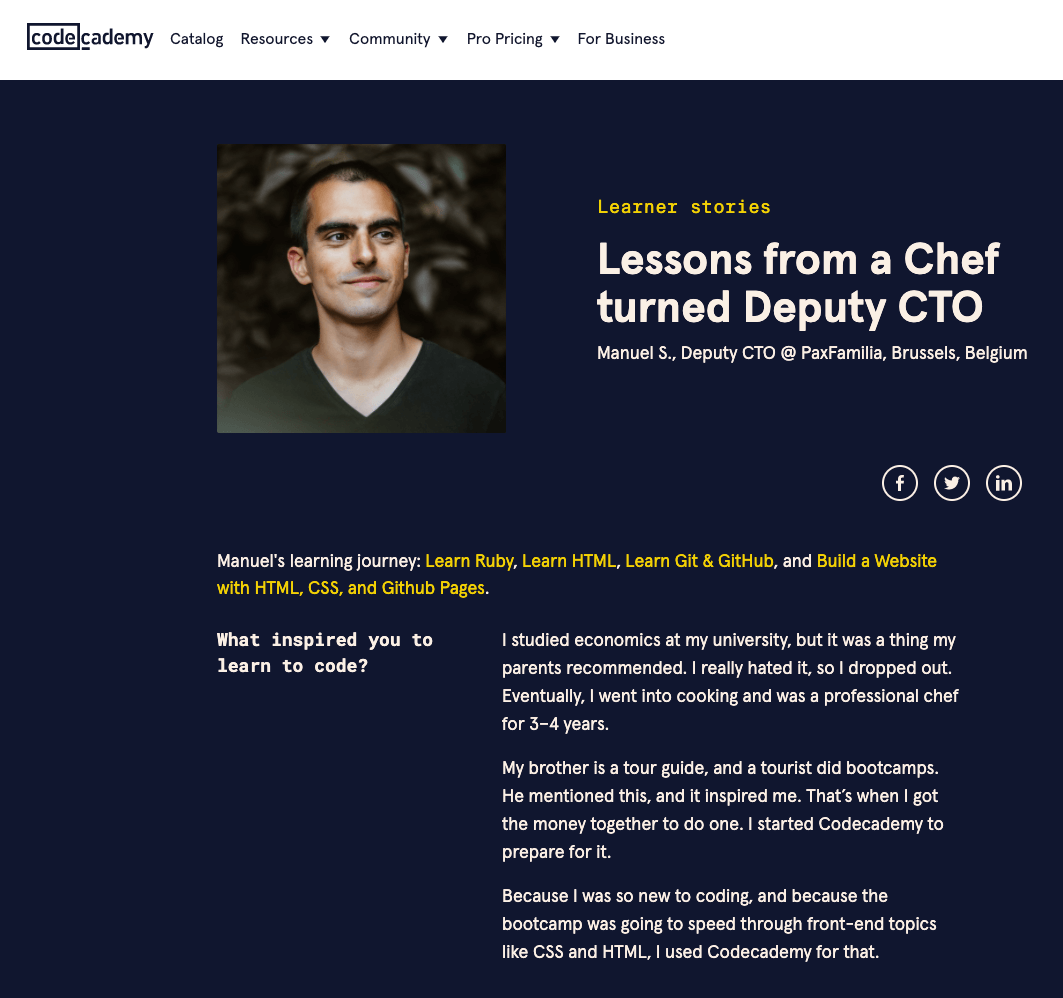
Codecademy takes the interview-based approach to talk about how it inspired people from all backgrounds to start learning to code. It asks relevant questions about your customer's experiences, such as:
- What inspired you to learn to code?
- How has coding impacted your life?
These questions help prospective customers get a glimpse into how Codecademy has been valuable in users’ lives.
2. altMBA
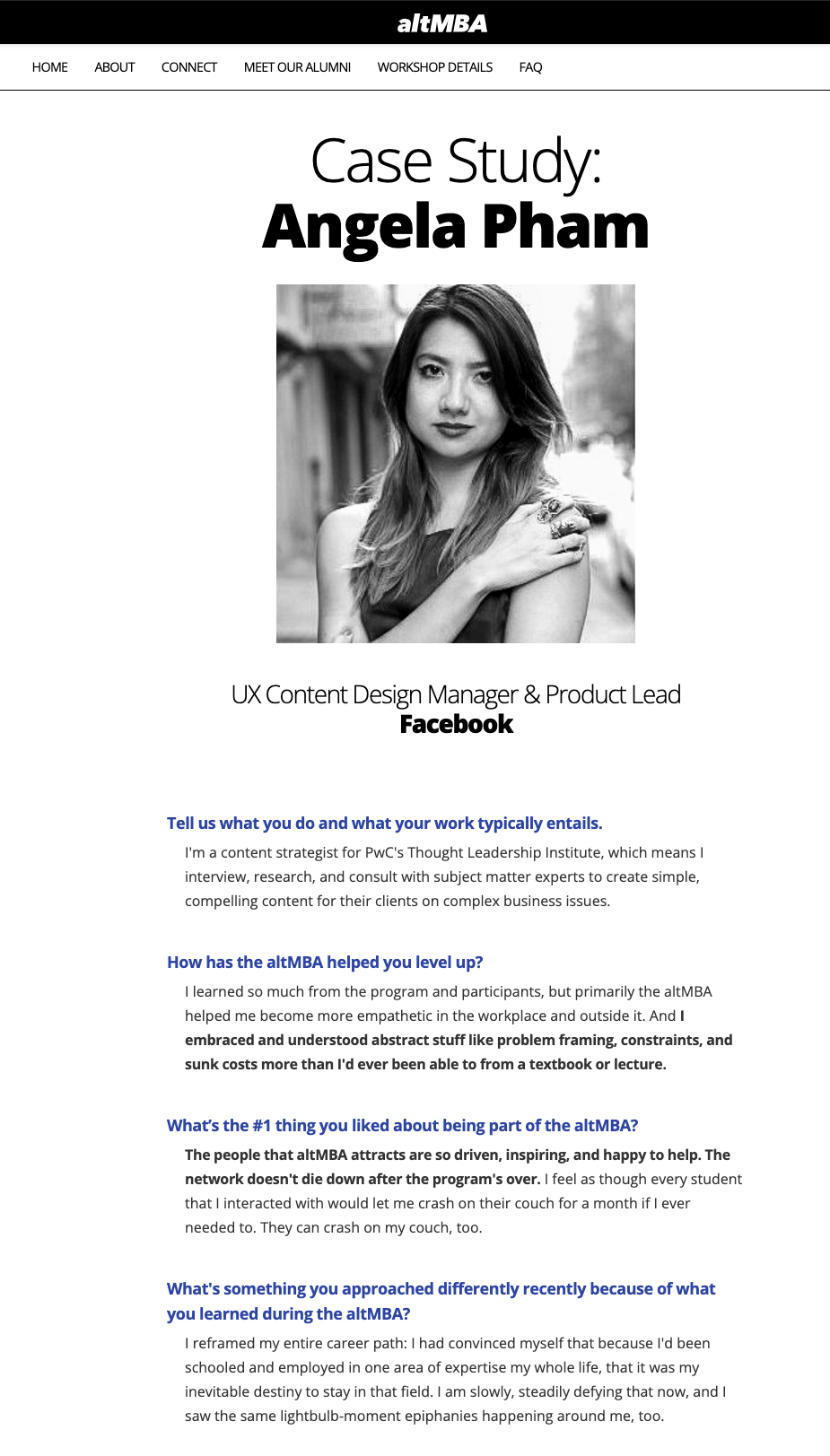
altMBA, an alternative MBA program run by Seth Godin, offers interview-based reviews from their alumni. They address simple questions that many prospective joinees may have in their minds, thus quenching their hesitations, objections, and skepticism.
3. Vocal Video
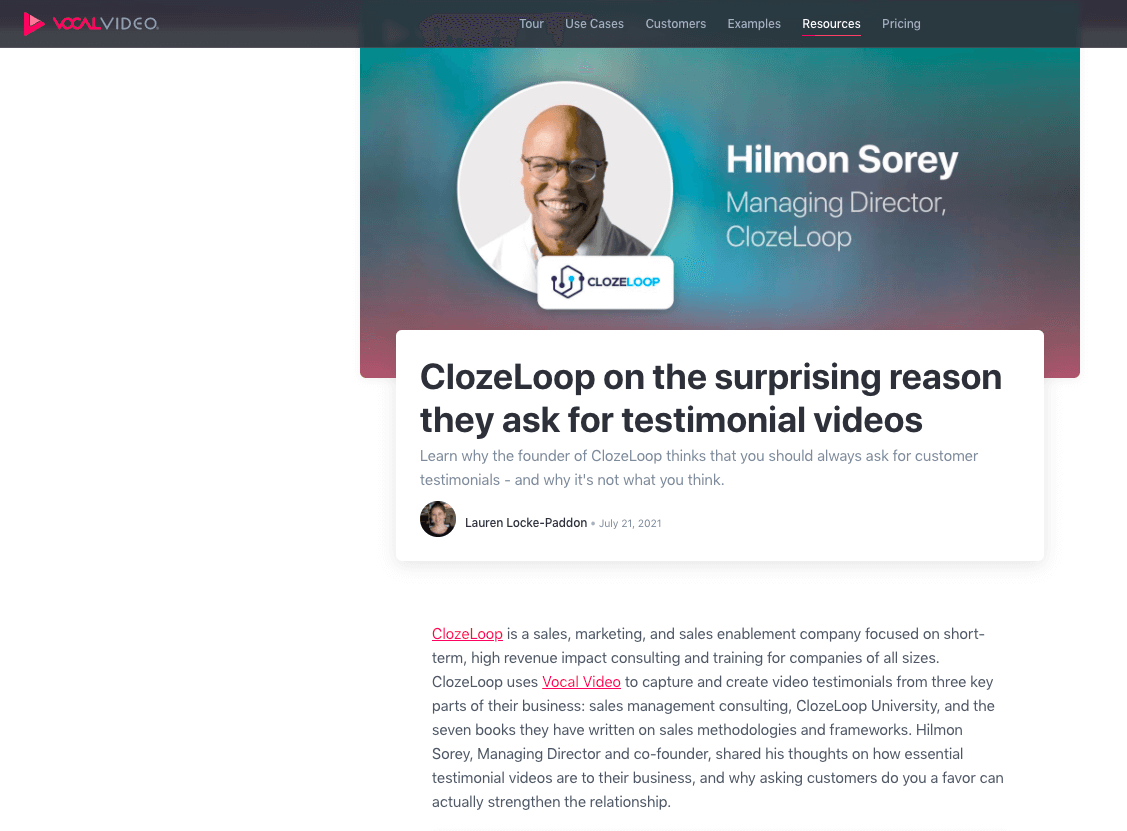
At Vocal Video, we use interviews as client testimonials, in video format.
Our clients record their testimonial videos by answering 3-10 questions. Our software then transcribes it into text, and we use a mix of video and interviews on this customer stories page.
Takeaways:
- Three to five questions: All the interviews above have limited questions that are highly relevant to what customers would usually want to know. For example, Codecademy asks, “How has coding impacted your life?” and altMBA asks, “How has altMBA helped you level up?”
- Easy page design: All three client testimonial examples have a similar layout: A photo of the interviewee at the top with their basic information like name and designation, followed by their written or video answers to the questions.
A template you can use:
Here are a few questions you can ask your interviewee to produce effective testimonials (taken from our library of templates that you can also refer to for your interviews):
- What problem were you or your company dealing with before [your organization name]?
- How did [your organization name] help resolve this challenge?
- What results did you get with [your organization name]?
Additional reading: We’ve written an in-depth post titled “You Don’t Need 15 Employee Testimonial Questions. Here Are the Only 3 You’ll Ever Need”. This post explains how to ask the right questions to get great testimonial videos. Though it’s meant for video testimonials, you can use this guide to create any kind of customer testimonials you want.
6. Customer Success Stories or Before-After Stories
Before-After customer stories are persuasive ways to get readers to understand the challenges existing customers faced before using the product and how their lives were impacted or improved after using the product.
Here are two examples:
1. charity: water Before-After Stories
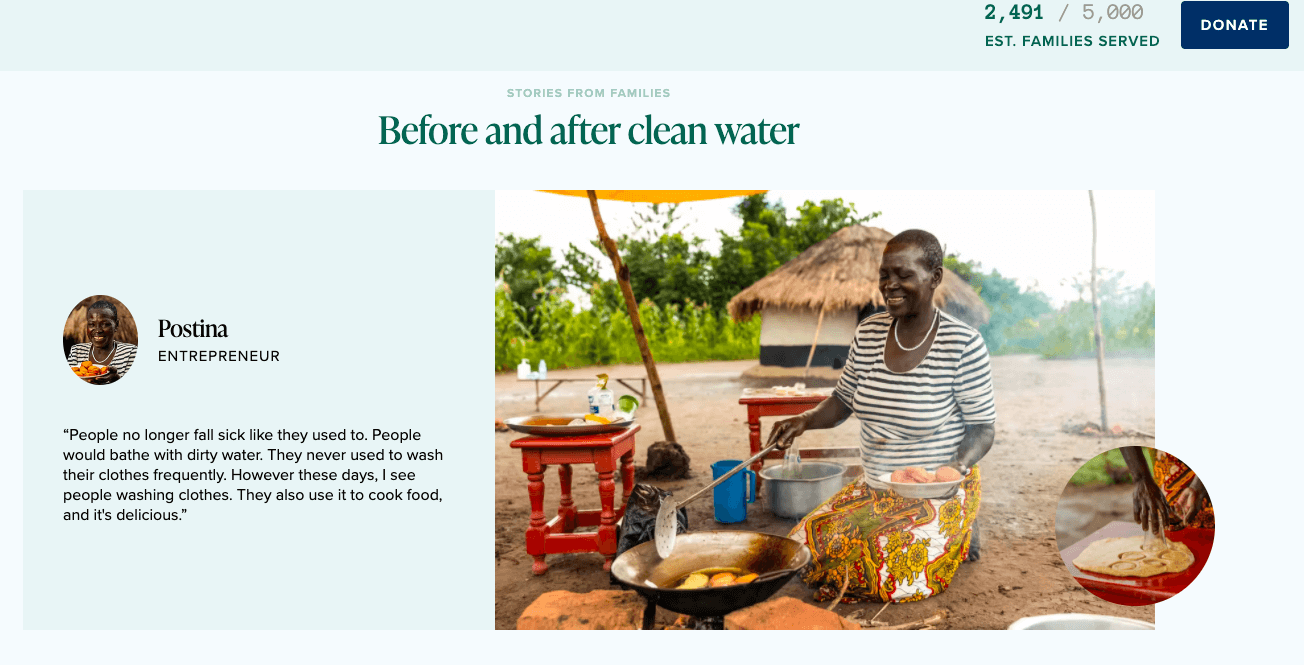
charity: water uses stunning imagery to talk about their before-after testimonials on the bottom of their homepage. Testimonials are short and crisp. They talk about before clean water and after clean water advantages in just a few sentences.
2. Basecamp Before-After Testimonials
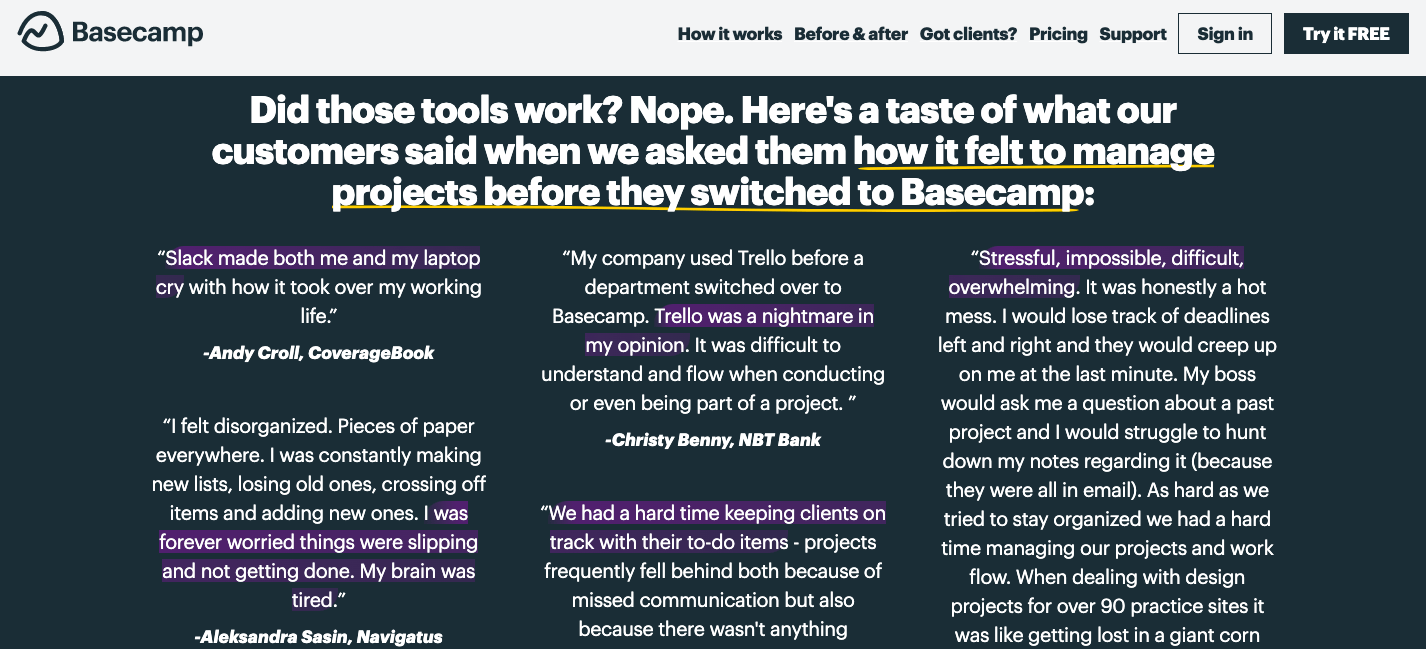
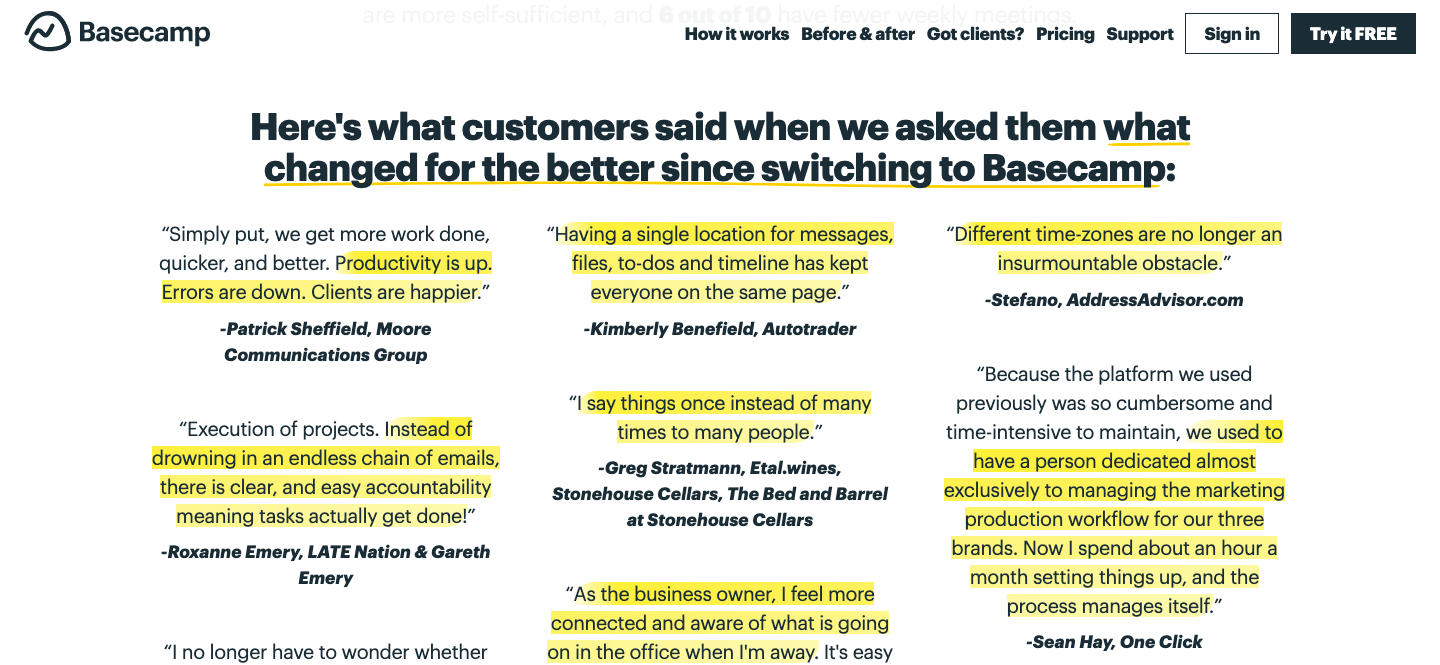
Basecamp doesn’t use imagery but uses creativity to display before-after testimonials — what they call “Night & day”.
For example, the “before” reviews have a very dark blue background (night), while “after switching to Basecamp” reviews have a white background (day), intelligently displaying the difference.
Takeaways:
- Use creativity: Both client testimonial examples above use creativity to depict the before-after change. Putting up plain text may seem boring, but showing it creatively hooks the reader, evokes emotions, and compels them to read more about your product.
- Keep them short: A good testimonial is short and to the point — readers don’t read everything, they just scan through the text.
- Amplify a key message: The best testimonials emphasize the core message or the value proposition of the product. For example, if the testimonial is related to productivity, mentioning that “to-dos and timelines kept everyone on the same page” amplifies that benefit.
A template you can use:
“Before [your organization name], I was facing [a specific challenge]. After [your organization name], I have experienced [2-3 benefits].”
7. Blog Post Reviews
In blog post testimonials, readers post a detailed review of using your product on their own blog.
Bloggers have a following in a specific domain area and a review about your product can resonate with their followers of that domain. These testimonials are informative and can help customers who are on the fence about making a decision.
One example here is a GetResponse Blog Review that is posted on Style Factory:
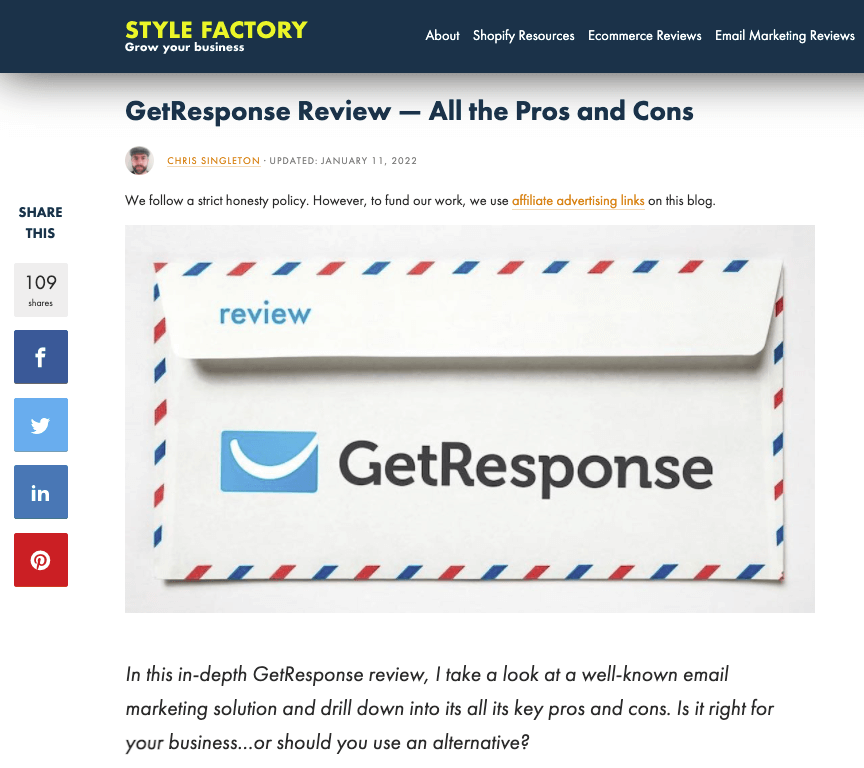
Another idea is to ask your customers for a review on their blog with an incentive like CoSchedule (write a review & get 50% off for an entire year!):
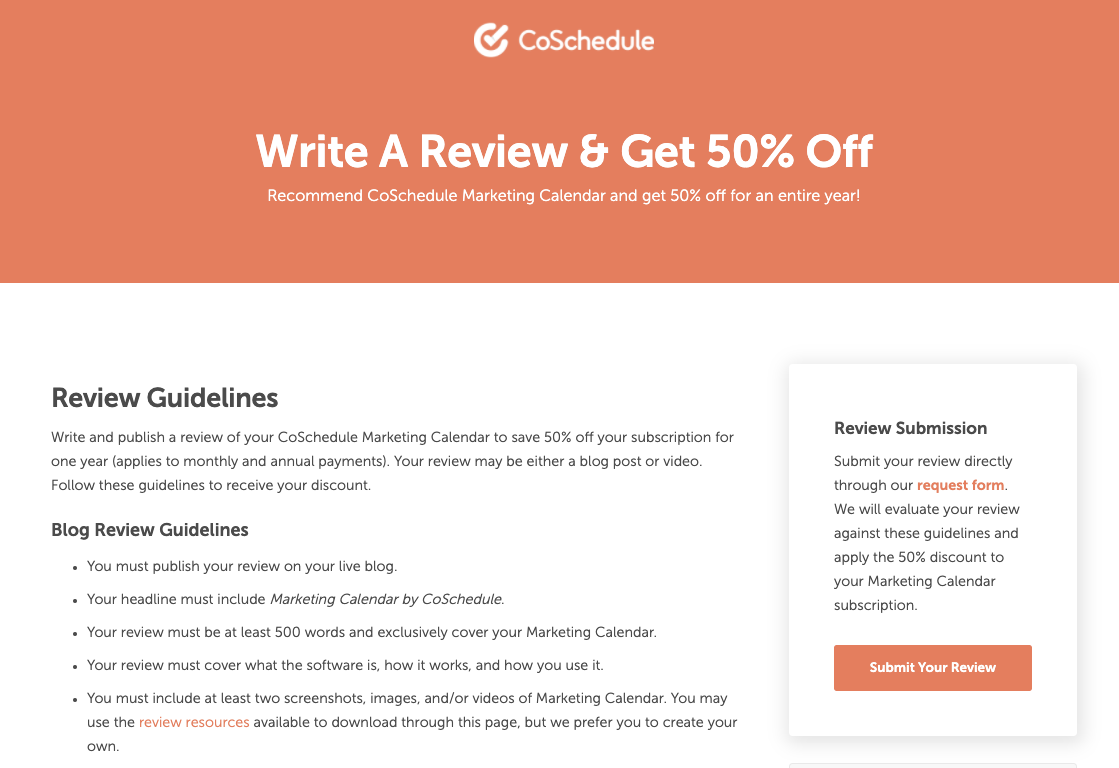
A blog post review can have a similar template to a case study testimonial, like we discussed above.
8. Third-Party Reviews
Many third-party websites like Capterra, G2, Trustpilot, Yelp, and Google Reviews offer testimonial services for organizations and brands. Here, you just have to send a link of your Capterra or G2 profile (or any other review service you use) to your customers, and they’ll write the reviews. Many of them also offer an option to record a video testimonial and upload it on the website.
With third-party testimonials, new customers get the confidence that they aren’t the first or the only ones who are looking to purchase a product/service. These review websites also offer filters or sort through options where customers can look out for reviews from customers they self-identify with.
For example, a marketing manager working with a team of 20 people may filter through thousands of positive reviews and show only those reviews that are put up by other marketing managers of the same team size.
Here’s an example of Booker.com’s review on Capterra:
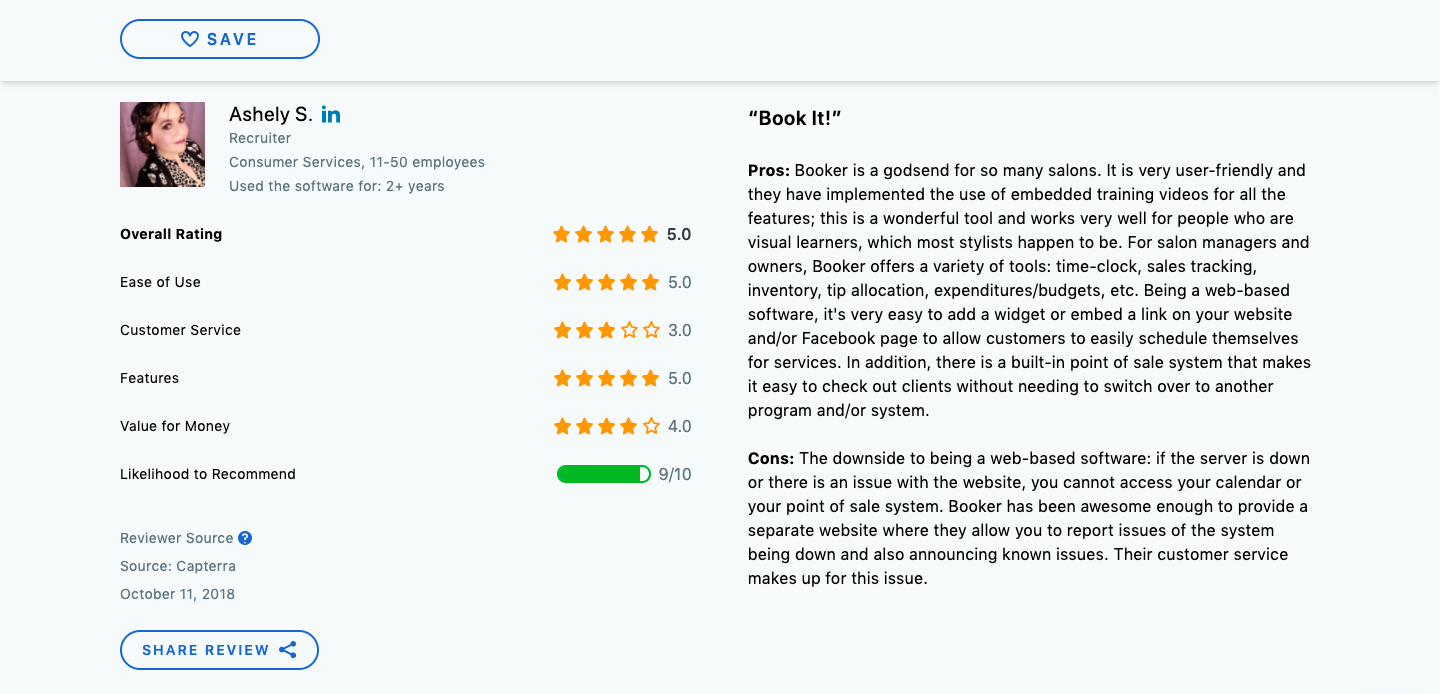
Takeaways:
- Third-party online review sites have social proof factors like star ratings for every feature, display photo, social media links to the reviewer’s profile, their designation, date of the review, and an unbiased review with ‘Pros’ and ‘Cons’.
- With this type of review, it’s essential that you keep the most updated or latest review at the top. Old or outdated reviews can signify that your company isn’t doing well or isn’t attracting satisfied customers to talk about the product.
A template you can use:
“I have used [Your product name] and am in love with their features like [explain 3-5 features that you like about the product]. It has helped us overcome [2-3 challenges you faced]. There are a few disadvantages [write 1-2 of them, this can be optional]. But overall, using [your product’s name] has been a great experience.”
9. Press Coverage
Press coverage, reviews, and endorsements from highly influential media outlets can generate a lot of positive buzz and be an asset you can link to long-term from your own website. The credibility and reach of the publications that post these reviews can have the power to shape the public's view about your product. These are most helpful when your target audience is in the publication’s readership demographic.
Here are two examples:
1. The Independent’s review on the HeadSpace App
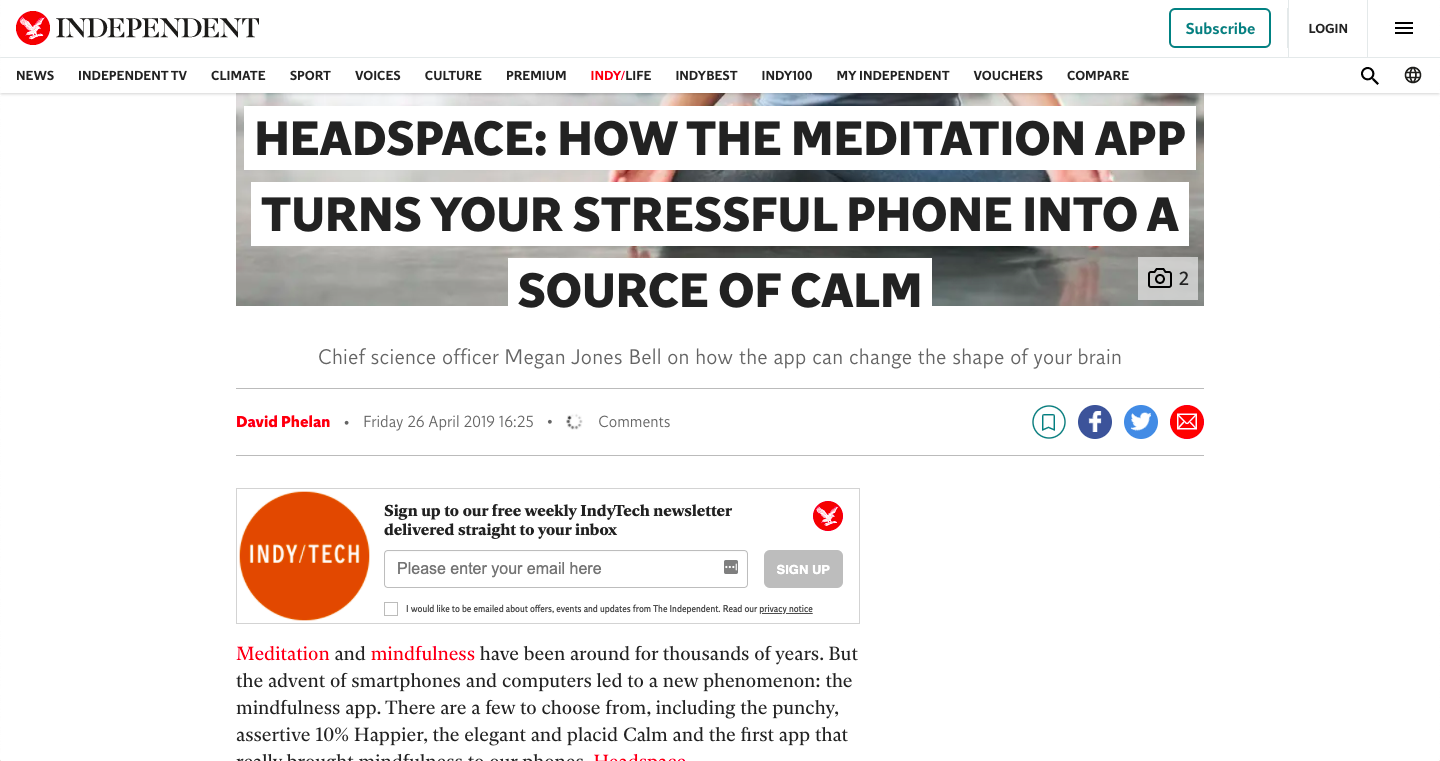
Here, The Independent reviews the popular meditation app, Headspace. It’s written by their “Chief science officer” and uses a scientific term of how meditation can “change the shape of your brain” to get more credibility and authenticity.
2. Square
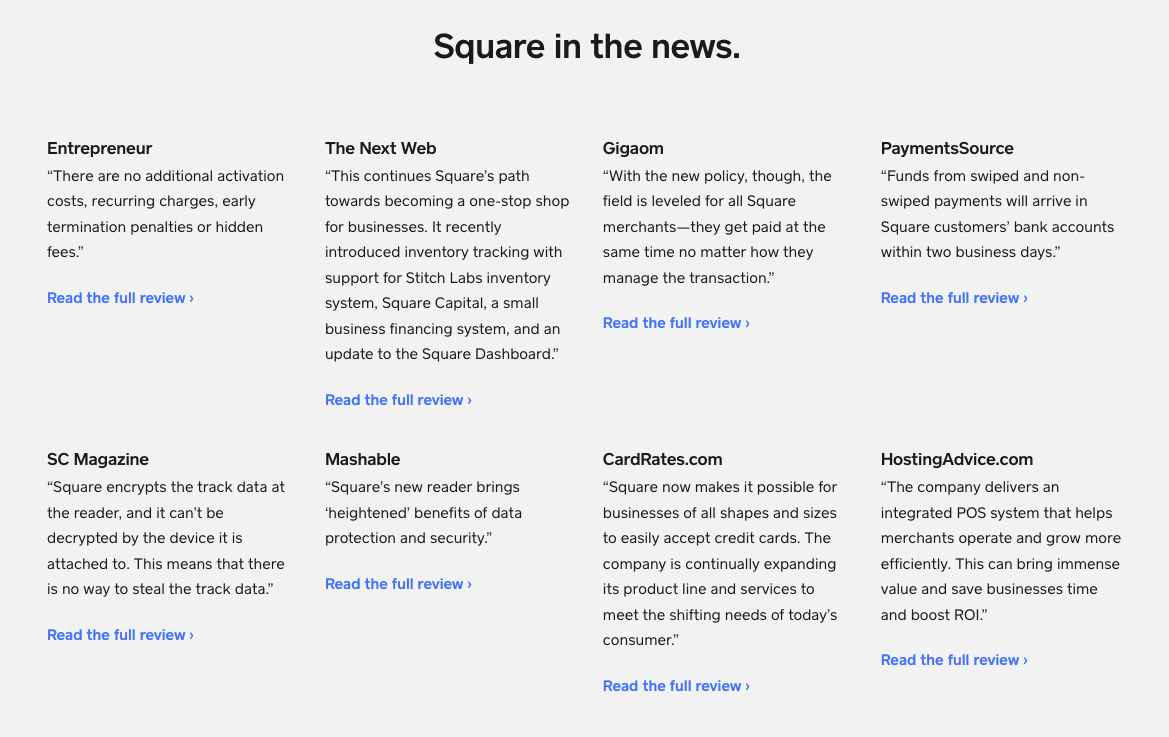
Square has a full section on their review page dedicated to press reviews — providing readers with insight into several different professional reviews of their product.
Takeaways:
Press reviews are powerful and compelling ways to get customers to believe in your product. The hard part about press reviews is, of course, getting them.
10. Influencers or Other High-Profile Testimonials
Influencer testimonials are reviews from subject matter experts in a particular industry who use your product and share a highly valuable perspective about it. These experts are famous in their niche and when they rave about using your product, readers are easily convinced to take action and make a purchase decision.
Here are two examples:
1. Copyhackers
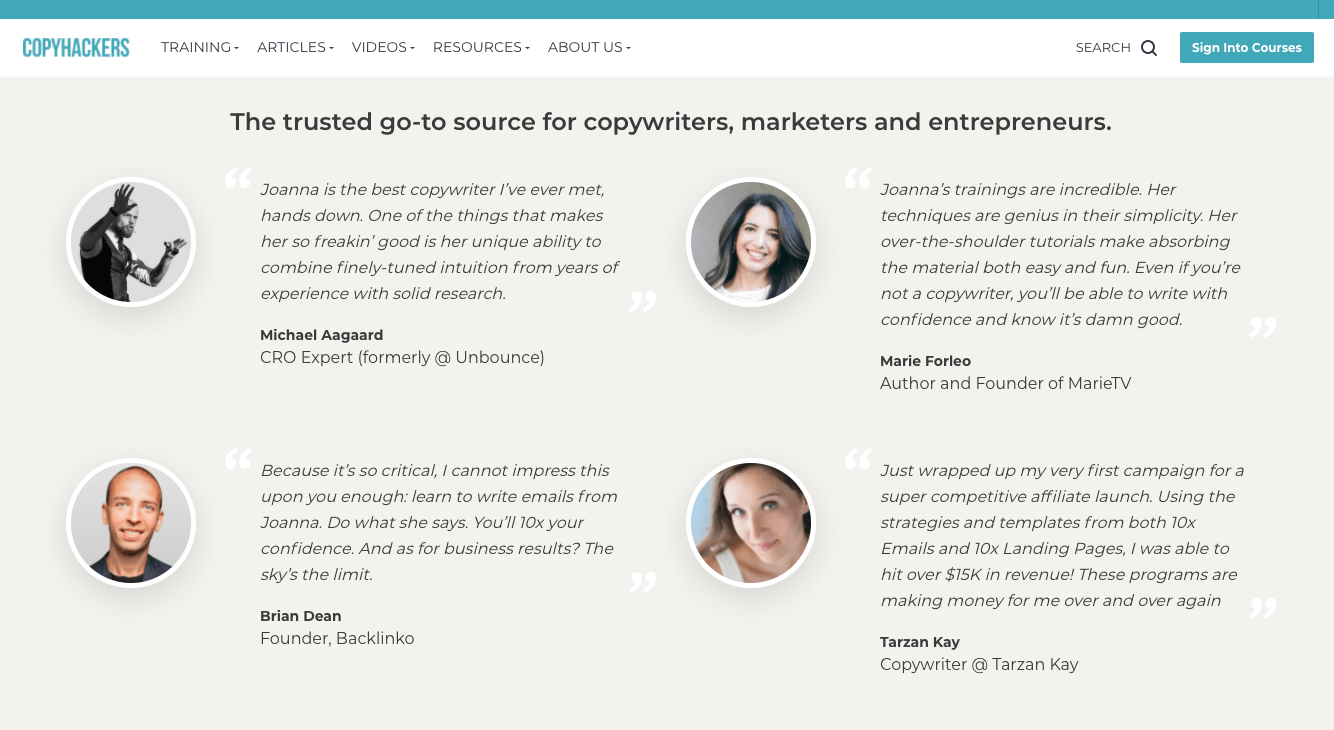
Copyhackers offers copywriting advice through blogs, online classes, and training videos.
On their homepage, they display four testimonials from highly influential authority figures in marketing — like Brian Dean from Backlinko and Marie Forleo from MarieTV. This immediately encourages new customers to explore more about what Copyhackers has to offer.
2. Four Sigmatic
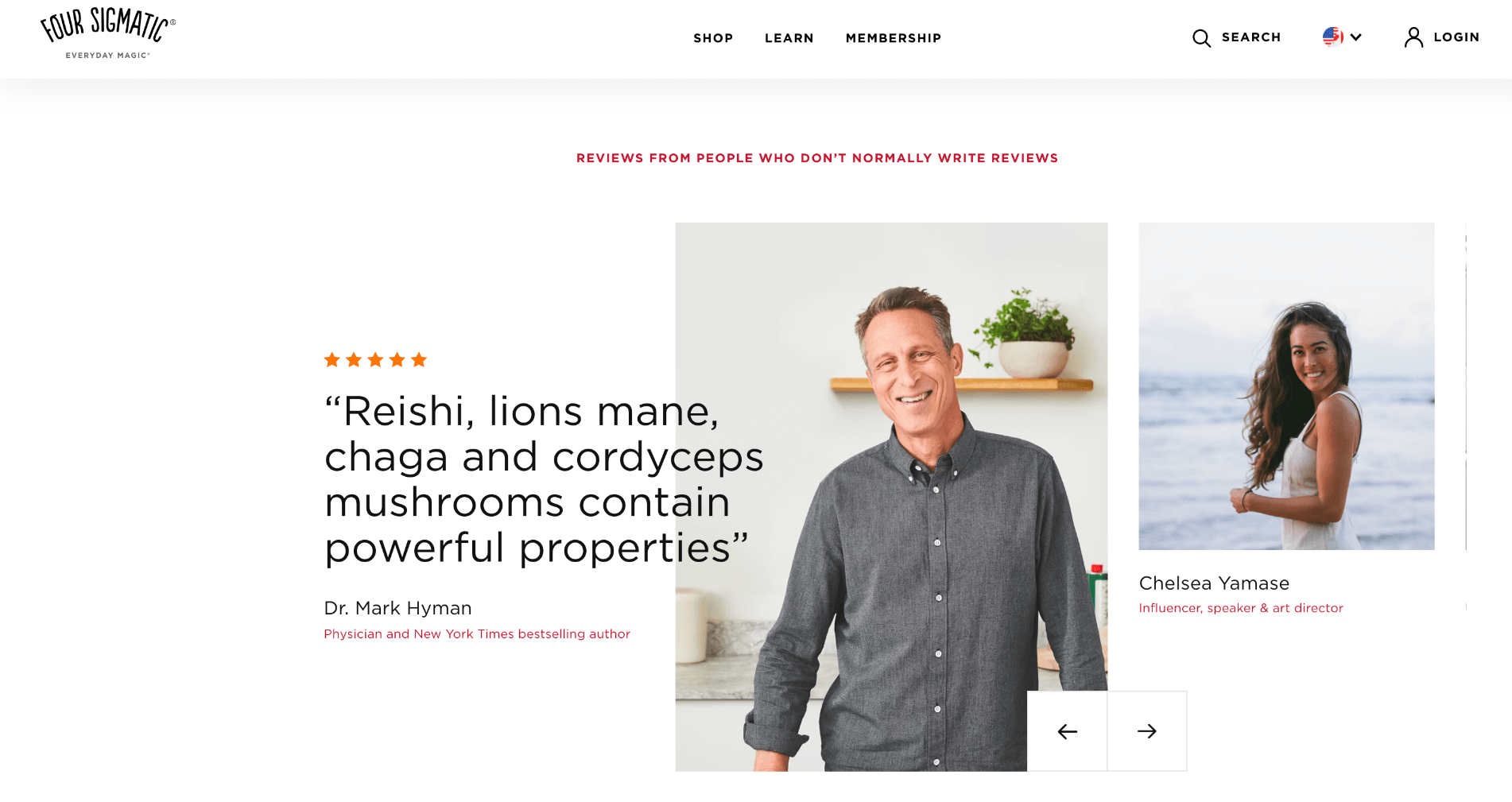
Four Sigmatic, a consumer-facing mushroom coffee brand, presents simple quotes on their homepage from influencers in the health and wellness space, including a New York Times bestselling author and an art director.
Of course, influencers have to be paid somehow (typically with cash or free products), and the more famous the person, the more they will ask to represent your brand. But even if you don’t have the budget for the level of influencers shown here, this same concept can be applied to micro-influencers.
Takeaways:
- You can use quotes, videos, case studies, or social media types of testimonials mentioned above to create authority testimonials.
- Having a photo along with the designation of the influencer writing the testimonials boosts trustworthiness. Plus, notice for all of them, images are displayed very prominently so that readers can immediately recognize the influencer.
- As seen in both examples above, it can be a good idea to place these testimonials right on the landing page, but you could place them anywhere you think it fits best on your website.
A template you can use:
You can use the templates above suggested for quotes, before-after reviews, and third-party reviews for these testimonials.
11. User-Generated Content
User-generated content usually refers to photos or videos that users or customers create and send to the brand (via email) or post on social media. Often these aren’t really “reviews” in the sense that they aren’t meant to be summarized in a neat quote as a “testimonial”. The customers are just posting photos of themselves using or opening the product or service. As a result, they feel more authentic (because they are), and can definitely take the place of testimonials, in particular for consumer-facing brands.
Puffin Packaging does this on their page quite simply — there’s no text, just photos that their customers send them via social media or email. Though there’s nothing to read, it’s easy to strike an affinity with their product, which contributes to building trust and raises the curiosity of the reader to know more about Puffin Packaging.
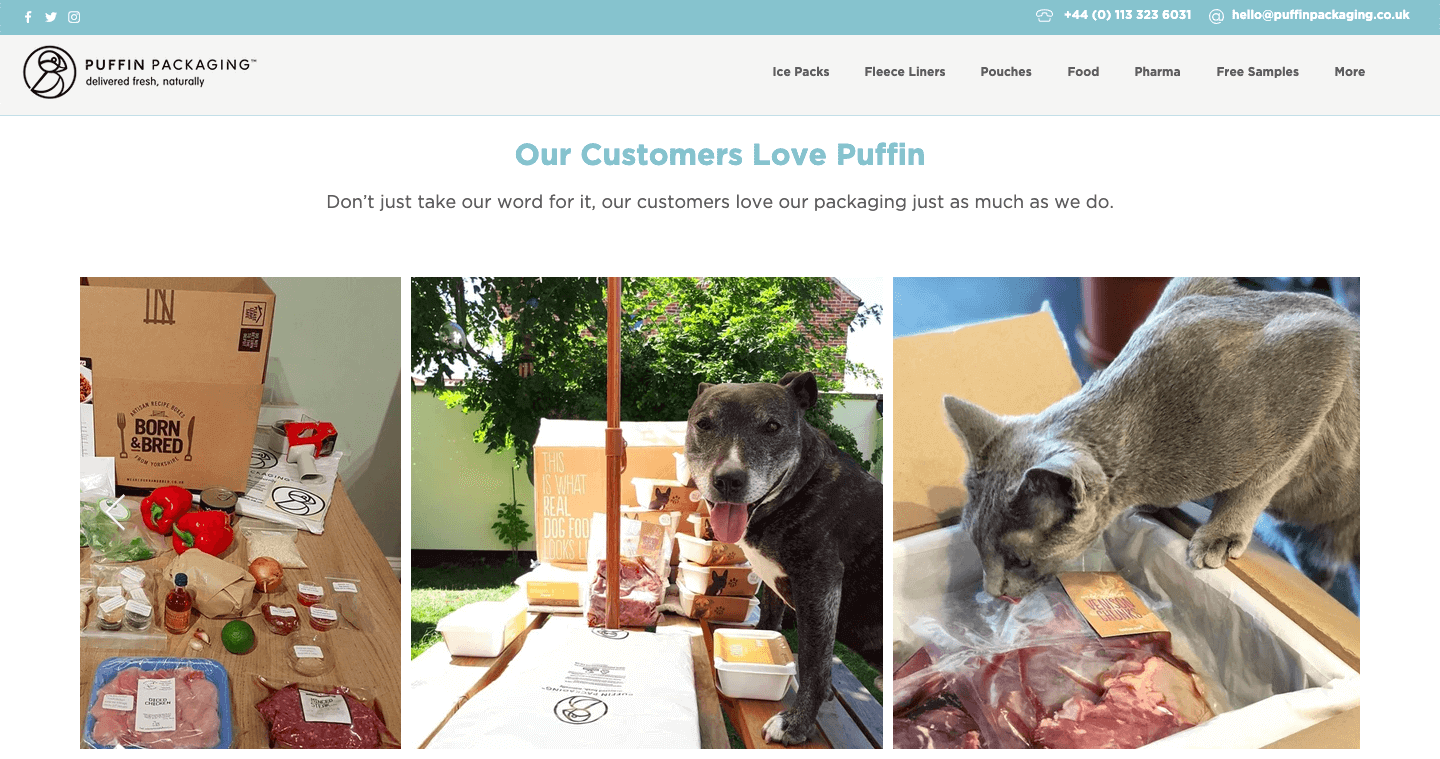
Takeaways:
- For user-generated content and testimonials, you can create an exclusive hashtag for your social media channels, like Twitter or Instagram, and invite your happy customers to post a photo of them using your product with your hashtag. You can then embed these handles on your page, where your potential audience can scroll through the testimonials. There are some tools that you can use to try to collect user-generated content — we cover a few of them in this post.
- You can use user-generated customer reviews as a part of your subsequent ad campaigns or content marketing efforts.
Additional reading: Client testimonials can provide you with immense possibilities of creating marketing ad campaigns; we talk more about testimonial advertising in this post with seven examples.
A template you can use:
Page design for these testimonials can be as creative as you want them to be. You can use images (like Puffin Packaging does), quotes, or videos that customers post on their social media accounts on your homepage, emails, or popups.
This post covered 11 types of client testimonial examples with templates for each type.
As a business owner, you can choose any type of testimonial, or have a mix of them to enhance your brand’s social proof and make them an essential part of your marketing strategy. Each type of testimonial plays a role in reinforcing your marketing messages to a diverse audience. A sustained effort in collecting customer testimonials boosts customer engagement and helps increase conversions.
We hope that after reading this article, you are geared up with many ideas and strategies to collect client testimonials in your preferred format. Just make sure you choose a tool like Vocal Video with the right functionality to easily create and display client testimonials.
If you want to easily create video testimonials with Vocal Video, sign up for a free account.